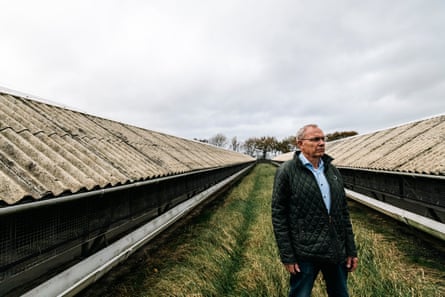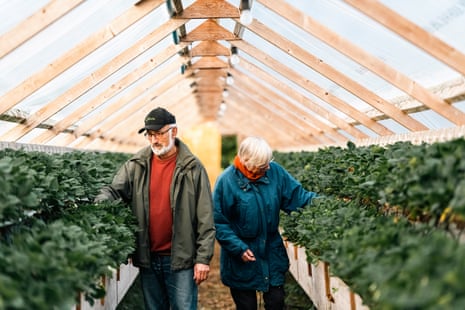The farm is quiet. Martin Merrild is sweeping leaves. Behind him is a row of 20 large sheds – all empty. Two years ago, his farm near Hjerm in West Jutland had been home to 15,000 mink, a small carnivorous mammal bred by farmers in individual cages before being skinned for its fur.
Since he started mink farming almost 40 years ago, Merrild’s life had revolved around a yearly cycle. It would start with a smaller population of female and male mink. In early March, the females would be ready for breeding and Merrild and his staff would have just a few weeks to ensure they got a mate. From late April, mink the size of a thumb would be born.

These would grow quickly over the summer months to about 3-4kg. They would be killed and skinned for their fur in November, with the cycle repeated the following year.
Across Denmark, more than 15 million mink were bred every year on farms like Merrild’s. Denmark was the world’s biggest producer of mink fur, at one point producing 40% of the world’s supply, mostly exported to Asia.
But on the morning of 4 November 2020, the industry came to a standstill as the Danish prime minister, Mette Frederiksen, announced the culling of the country’s entire farmed mink herd: 15 million animals.




Twelve people had become infected with a Covid-19 mutation that originated in mink and Frederiksen feared the mutation, if left unchecked, could jeopardise future vaccines.
Soon after the announcement, veterinary officials came to kill Merrild’s animals. His sheds have remained largely untouched ever since.

“We’re lucky as we’ve had other things to do on the farm,” says Merrild, who also grows food crops and has a flock of poultry. “But there are men who’ve only ever worked with mink their whole lives. They were on a mink farm every day. And now nothing for two years.”
Half an hour south of Merrild’s farm is a collection of large warehouses emblazoned with the illustration of a mink. They belong to a company that had been feeding 3 million mink across the region, trucking out hundreds of tonnes of feed to farms every day during the peak summer months.

-
Much of the supporting industry, including companies who produced feed for the mink, have been mothballed since the Danish government shutdown the industry
Today, it feels like a half-empty museum without any visitors. Staff at the site have found other jobs, but the buildings and machinery remain mothballed as the owners await the outcome of a compensation claim.
“I just wish it would end. The business is over so we just want to be able to move on now,” says the company’s former chairman.



There are more than 1,000 former mink farmers, like Merrild, who are still waiting on the outcome of their compensation claims. Unable to dismantle their barns, they are farming ghosts.
Aase Rask had worried for the health of her husband, Ejner, then 68, as his mink were taken away and killed. He had known nothing else since the early 1980s, with their son lined up to take over the farm near Holstebro, West Jutland.
They see few viable alternatives for making the farm profitable and their son is now trying to forge an alternative career in machinery.

-
Aase and Ejner Rask had been solely farming mink on their farm near Holstebro, Denmark since the early 1980s
But Ejner has at least found a new and unlikely passion: growing strawberries. Over the past two years, four of his sheds have been filled with berries, along with a small amount of peppers, potatoes and other vegetables. The couple sell them during the summer months on a stall by the roadside.
Even now, with the onset of winter, the mink cages are partly hidden by the green leaves of the plants.
“It’s more of a hobby and just about keeps my brain active, so I’m not just sitting down,” says Ejner. “It has been cheaper than going to a psychologist. At least strawberries don’t bite and everyone likes them.”




The Danish government recently agreed to allow mink farming to restart after an official inquiry found its shutdown lacked legal justification. Although there were outbreaks of Covid in farmed mink across the world, Denmark was the only country to order a wholesale cull and shutdown its industry.
But after two years, many of the 5,000-plus vets, feed manufacturers, auctioneers and advisers involved have moved on, with just a handful of farmers expected to pick up where they left off. Everyone else is just waiting to see their cages removed.

“We knew quickly that the mink would not be coming back. The infrastructure supporting the industry has gone now. It’s over,” says Merrild.
At 67, the delays to compensation have left him feeling too old to consider replacing the mink with something else. “The best thing for the value of the farm [if we sell it] is to get the mink stuff away now,” he says.

You can send us your stories and thoughts at [email protected]
Stay connected with us on social media platform for instant update click here to join our Twitter, & Facebook
We are now on Telegram. Click here to join our channel (@TechiUpdate) and stay updated with the latest Technology headlines.
For all the latest Covid-19 News Click Here
